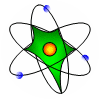|
Experiments with mammalian and human cells were performed on the Nuclotron beams (12C ions, 473 MeV/nucleons, and the protons, 1 GeV) and on the 60Co g - irradiation. Nonlinear dependence of the number of cells with chromosomal damage on the dose is established. The obtained data show that the inducible repair at 12C ion irradiation occurs at lower doses and repair chromosomal damage more effectively than at gamma-ray action. No essential quantitative difference in the frequency of the cells with chromosomal damages was obtained, although the LET value of 12C ions was more than 10 times higher than LET of the protons (10.65 keV/mm - and 0.218 keV/mm -, respectively). There was no efficiency difference in the case of g - irradiation either.
* N.L. Shmakova et al. Medical Radiology and Radiation Safety. 2002. Vol. 47. Num.3. P. 5-13
Chromosomal damage induced by low doses of 60Co g - irradiation in human peripheral blood lymphocytes has been studied. At the dose range 0,01-0,05 Gy the cells have shown the highest radiosensitivity; at 0,05-0,5 Gy the dose-independent induction of chromosome damage has been revealed. At the doses of 0,5-1,0 Gy the dose-effect curves have become linear with the decreased slope compared to the initial one (by factor of 5 to 10 for different criteria), reflecting higher radioresistance of cells. At GSI (Darmstadt, Germany) in collaboration with Biophysics Group the investigation of cellular response to radiation of different quality of normal healthy human tissue cells has been performed. To further investigate the cellular response of normal human fibroblasts to radiation of different LET confluent AG1522B cells were exposed to accelerated carbon ions 200 and 16 MeV/mm -, Ni ions 11 MeV/mm - (LET 16, 155 and 2455 keV/mm -, respectively) and X-rays. A slight increase in the frequencies of aberrant cells and aberrations with sampling time has been found after the exposure of human fibroblasts to X-rays and 200 MeV/mm - С ions, while a more pronounced increase was detected after irradiation with 11 MeV/mm - С and Ni ions indicating the transient cell cycle delay of most heavily damaged cells.
* R.D. Govorun et al. Adv.Space Res. 2002. Vol. 30. No 4. P. 885-890.
* K.A. Lyubimova, N.A. Koltovaya, E.A. Krasavin Proceedings II International Symposium "Problems in Biochemistry, Radiation and Space Biology". Dubna. 2002. Vol.1. P. 171-173.
The study of mutation induction of different nature on ionising radiation using yeast Saccharomyces cerevisiae as model system of eucaryotic cells was continued.
The study of genetic control of DNA damage-induced arrest of cell cycle progression, named checkpoint-control, was continued. It was determined that CDC28 and RAD53 genes belong to two different branches of the pathway controlling the radiosensitivity.
* N.A. Koltovaya, A.B. Devin. Reports of Russian Acad. Sci. 2002. Vol. 387. P. 1-4.
The consequences of transposon TnIO precise excision in Escherichia coli induced by heavy ions with different LET were studied. Survival curves were obtained to define radiosensitivity of the cells after accelerated helium ions irradiation with LET from 20 to 100 keV/mm -, and accelerated carbon ions С with LET 200 kev/mm -. The relative biological effectiveness (RBE) maximum by the lethal action criterion was found after accelerated "He ions irradiation with LET= lOOkeV/mm -. From the calculation of the reversions in the E. coli gene cysC95::TnlO the relative frequency of the precise excision as the function of the different heavy ions irradiation doses was found. The maximum of this RBE function was found in the interval from 20 to 50 keV/mm -. From this fact the conclusion can be drawn that on the background of the initiation of the induced precise excision lies the same cluster DNA breaks, as for the induction of the gene mutations.
* D.V. Zhuravel, A.V. Boreiko Radiation Biology. Radioecology. 2002. Vol. 42. No 5. P. 488-491.
|





